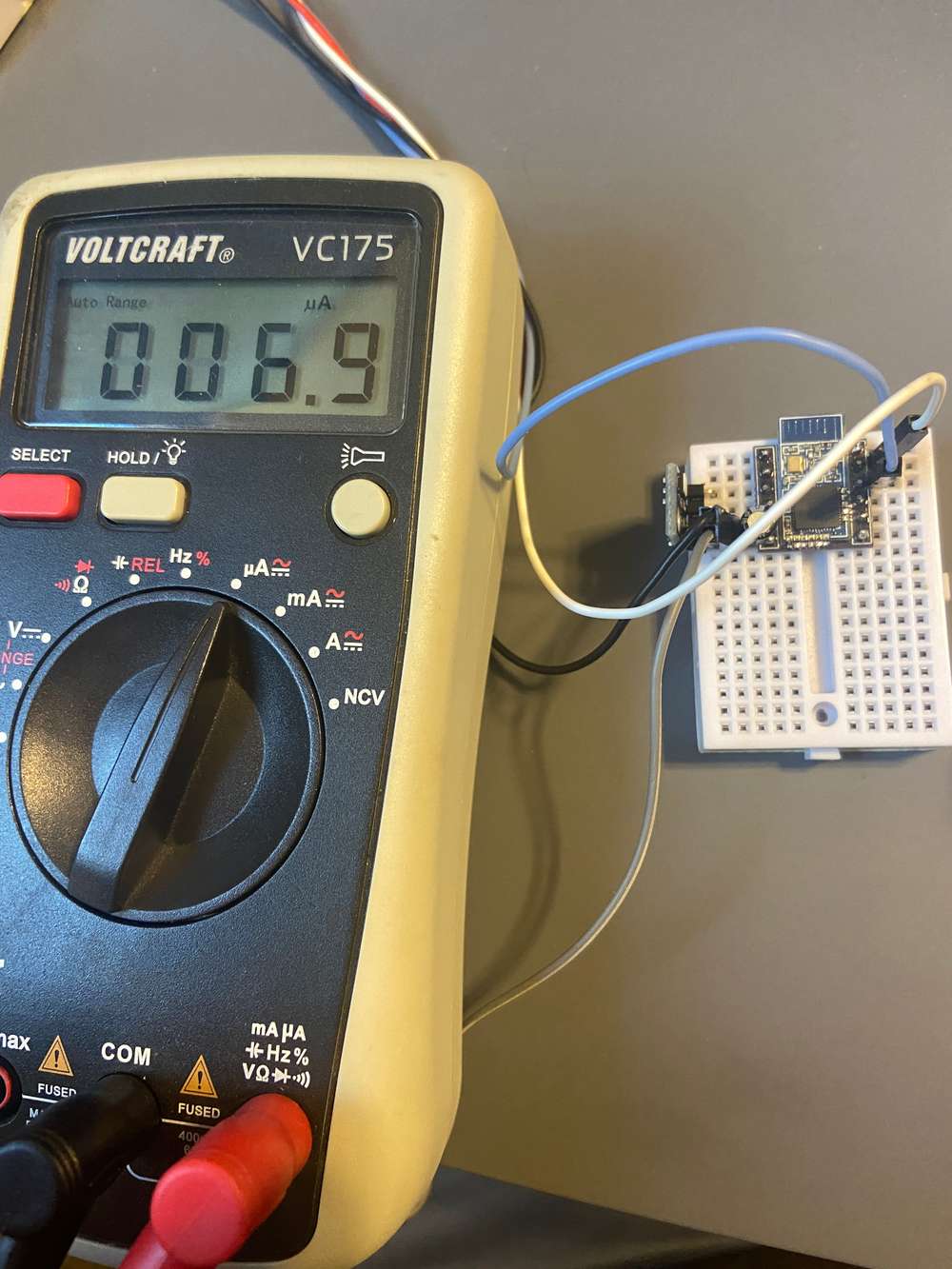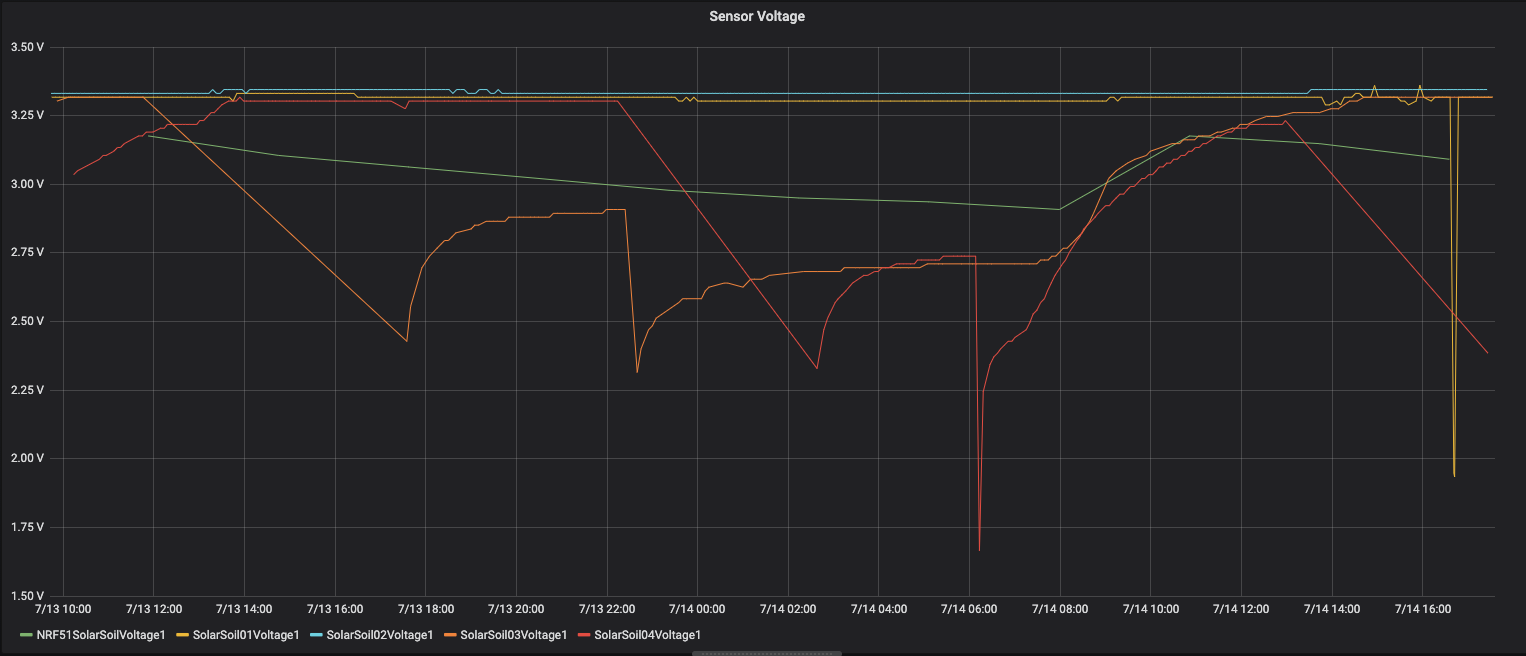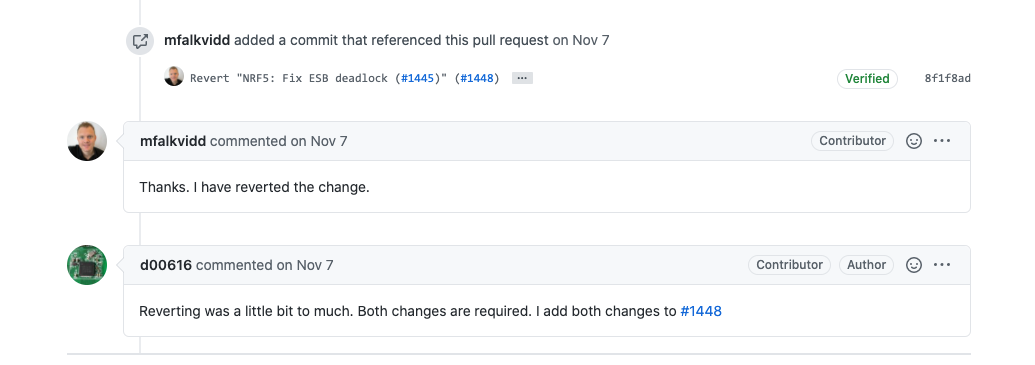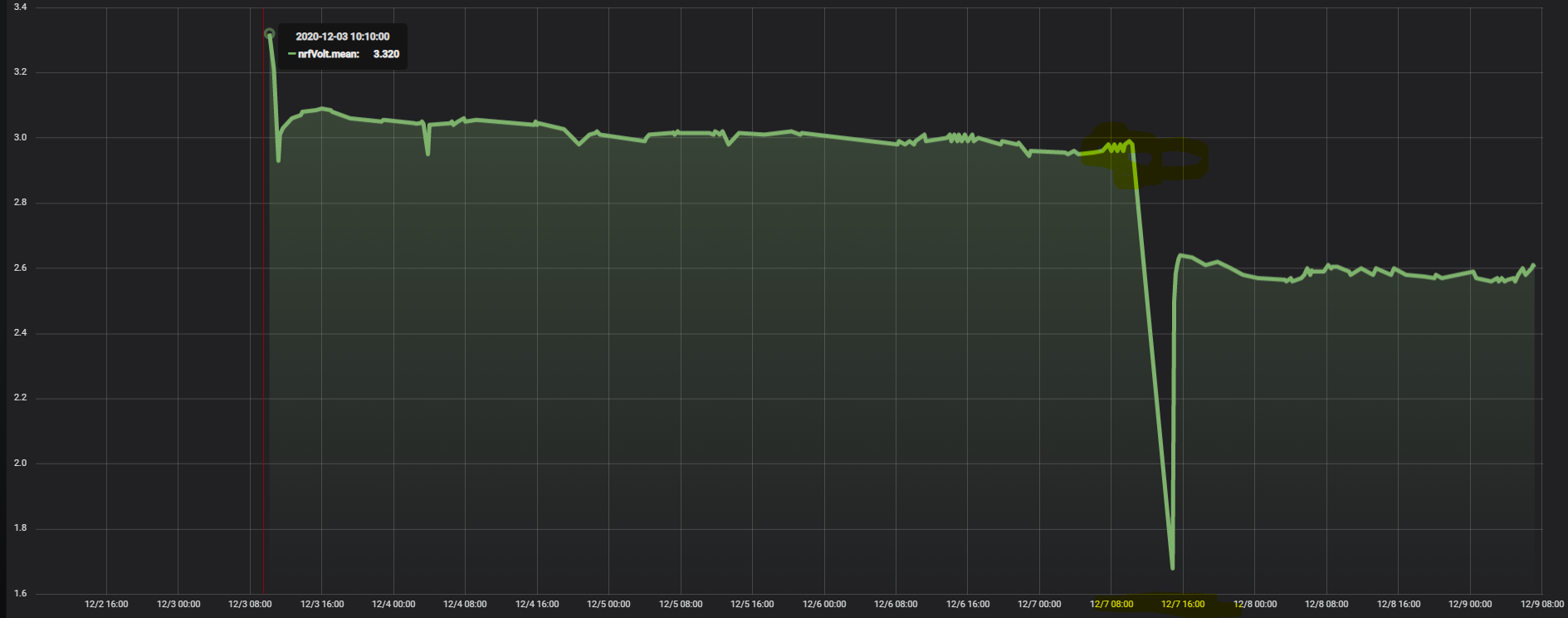High power consumption NRF52832 & SI7021
-
@ncollins sure:
be aware, i'm not a coder. i just hack crap together to the point that it works then move on.
// SUMMARY: This demo sketch runs on MultiSensor Version 7 board with an I2C Si7021 module to transmit temperature, humidity, and battery voltage to a MySensors gateway using MySensors protocols. // Note: because this is a passive node, node ID must be set manually to a unique sensor node ID: #define MY_NODE_ID 150 // Passive mode requires static node ID /** * The MySensors Arduino library handles the wireless radio link and protocol * between your home built sensors/actuators and HA controller of choice. * The sensors forms a self healing radio network with optional repeaters. Each * repeater and gateway builds a routing tables in EEPROM which keeps track of the * network topology allowing messages to be routed to nodes. * * Created by Henrik Ekblad <henrik.ekblad@mysensors.org> * Copyright (C) 2013-2017 Sensnology AB * Full contributor list: https://github.com/mysensors/Arduino/graphs/contributors * * Documentation: http://www.mysensors.org * Support Forum: http://forum.mysensors.org * * This program is free software; you can redistribute it and/or * modify it under the terms of the GNU General Public License * version 2 as published by the Free Software Foundation. * ******************************* * * REVISION HISTORY * Version 1.0 - tekka * * DESCRIPTION * Passive node example: This is a passive & independent reporting node * */ // This demo sketch uses the LowPowerLab SI7021 library and also some of its sample code: https://github.com/LowPowerLab/SI7021 // This demo sketch also draws from the MySensor's example MockMySensors sketch. // This demo sketch also draws from some of the code posted by smilvert here: https://forum.mysensors.org/topic/7961/why-do-passive-nodes-need-to-set-their-node-id-manually/14 #define SHORT_WAIT 50 #include <Wire.h> #include <SparkFunHTU21D.h> HTU21D myHumidity; // Enable debug prints //#define MY_DEBUG // Enable passive mode #define MY_PASSIVE_NODE #define MY_PARENT_NODE_IS_STATIC #define MY_PARENT_NODE_ID 0 #define MY_TRANSPORT_MAX_TSM_FAILURES 2 #define MY_SLEEP_TRANSPORT_RECONNECT_TIMEOUT_MS 3000 #define MY_TRANSPORT_WAIT_READY_MS 10000 #define MY_SLEEP_TRANSPORT_RECONNECT_TIMEOUT_MS 5000 // Enable and select radio type attached //#define MY_RADIO_NRF24 #define MY_RADIO_NRF5_ESB //#define MY_RADIO_RFM69 //#define MY_RADIO_RFM95 #include <MySensors.h> #define CHILD_ID_TEMP 0 //definitions contributed by smilvert (see above credit) #define CHILD_ID_HUM 1 // Initialize general message MyMessage msgTemp(CHILD_ID_TEMP, V_TEMP); MyMessage msgHum(CHILD_ID_HUM, V_HUM); #define ID_S_MULTIMETER 28 MyMessage msg_S_MULTIMETER_V_VOLTAGE(ID_S_MULTIMETER,V_VOLTAGE); //float lastTemperature=0; float lastSentTemp=0; int lastSentHumd=0; //float lastHumidity=0; float lastVoltage=0; float batteryVoltage=0; float temperature=0; int humidity=0; unsigned long time; void setup() { myHumidity.begin(); NRF_CLOCK->INTENSET=B11; //enable interrupts for EVENTS_HFCLKSTARTED and EVENTS_LFCLKSTARTED NRF_CLOCK->TASKS_HFCLKSTART=1; //start the high frequency crystal oscillator clock while (!(NRF_CLOCK->EVENTS_HFCLKSTARTED)) {} //wait until high frequency crystal oscillator clock is up to speed and working wait(SHORT_WAIT); } void presentation() { // Send the sketch version information to the gateway and controller sendSketchInfo("NRF51822 Temp & Humidity", "1.0"); // Register all sensors to gw (they will be created as child devices) present(CHILD_ID_TEMP, S_TEMP); wait(SHORT_WAIT); present(CHILD_ID_HUM, S_HUM); wait(SHORT_WAIT); present(ID_S_MULTIMETER,S_MULTIMETER,"Electric Station"); wait(SHORT_WAIT); } void loop() { myHumidity.begin(); //power consumption add // get humidity and temperature in one shot, saves power because sensor takes temperature when doing humidity anyway float temperature = myHumidity.readTemperature(); temperature = (temperature*1.8)+32; wait(SHORT_WAIT); float humidity = myHumidity.readHumidity(); //temperature = float(temperature*1.8)+32; batteryVoltage=((float)hwCPUVoltage())/1000.0; //take voltage measurement after transmission to hopefully measure lowest voltage that occurs. if ( (temperature > lastSentTemp + .1) || (temperature < lastSentTemp - .1) ) { send(msgTemp.set(temperature,2)); lastSentTemp = temperature; } if ( (humidity > lastSentHumd + 1) || (humidity < lastSentHumd - 1) ){ send(msgHum.set(humidity,0)); lastSentHumd = humidity; } //if ( batteryVoltage > (lastVoltage+.1) || batteryVoltage < (lastVoltage-.1) ) { send(msg_S_MULTIMETER_V_VOLTAGE.set(batteryVoltage,2)); //send battery voltage with 2 decimal places //lastVoltage = batteryVoltage; //} time = millis(); if (time > 64800000 ) { reboot(); } NRF_TWI0->ENABLE = 0; //possible power consumption adds NRF_TWI1->ENABLE = 0; sleep(180000); //sleep for three minutes } void reboot() { wdt_disable(); wdt_enable(WDTO_15MS); while (1) {} }@waspie Thanks for sharing. First thing I notice is you can probably remove:
NRF_CLOCK->INTENSET=B11; NRF_CLOCK->TASKS_HFCLKSTART=1; while (!(NRF_CLOCK->EVENTS_HFCLKSTARTED)) {}from your setup(). I believe this is legacy code that is now built in to MySensors / nRF5-arduino, and managed based on the features you're utilizing.
I just tested power consumption on NRF51822 with SI7021. Similar to your sketch but using the LowPowerLab SI7021 library.
I didn't have to do any hack or workaround to get ~7uA power consumption.

I'm using MySensors 2.3.2, SandeepMistry/nRF-Arduino 0.6. Just to be sure, I also reburned the bootloader.
I will try to get your sketch running on my NRF51, see if I can rule out the specific library as a cause for your power issues.
#define MY_RADIO_NRF5_ESB #define MY_NODE_ID 68 #define MY_PARENT_NODE_ID 13 #define MY_PARENT_NODE_IS_STATIC #define MY_PASSIVE_NODE #define MY_TRANSPORT_UPLINK_CHECK_DISABLED #define MY_TRANSPORT_CHKUPL_INTERVAL_MS 2000 #define MY_TRANSPORT_WAIT_READY_MS 1000 #define MY_SLEEP_TRANSPORT_RECONNECT_TIMEOUT_MS 2000 #define SLEEP_SHORT_MS (5000) #define SLEEP_MS 1000 * 60 * 1 #define REBOOT_HRS 24 #define REBOOT_MS 1000 * 60 * 60 * REBOOT_HRS #define BATTERY_SEND_MS REBOOT_MS unsigned long sleepTime = BATTERY_SEND_MS; unsigned long lastReboot = 0; unsigned long lastBatterySent = 0; unsigned long lastTemperatureSent = 0; bool firstBoot = true; #include <MySensors.h> #include <SI7021.h> MyMessage msgBattery( 1, V_VOLTAGE ); MyMessage msgTemperature( 3, V_TEMP ); MyMessage msgHumidity( 4, V_HUM ); static SI7021 sensor; void setup() { enableReset(); sensor.begin(); } void loop() { bool sendBattery = millis() - lastBatterySent >= BATTERY_SEND_MS || firstBoot; bool shouldReboot = millis() - lastReboot >= REBOOT_MS; const float temperature = float( sensor.getFahrenheitHundredths() ) / 100.0; const float humidity = float( sensor.getHumidityBasisPoints() ) / 100.0; sleep(SLEEP_SHORT_MS); send( msgTemperature.set( temperature, 2 ) ); sleep(SLEEP_SHORT_MS); send( msgHumidity.set( humidity, 2) ); if(sendBattery){ sleep(SLEEP_SHORT_MS); bool sent = send(msgBattery.set(getInternalVoltage(),3)); if(sent) lastBatterySent = millis(); } if(shouldReboot){ lastReboot = millis(); hwReboot(); } firstBoot = false; sleep(SLEEP_MS); } void present() {} float getInternalVoltage(){ return ((float)hwCPUVoltage())/1000.0; } void enableReset(){ NRF_POWER->RESET = 1; while (NRF_POWER->RESET != 1); } -
@ncollins thanks bud!
with the htu21 the sleeping consumption is sub 5ua. its been 4 days and hovering around 3 volts. i'm keeping my fingers crossed. Would love to reliably use these. Since I had so much trouble with them I designed and put into use atmega328p boards quite a while ago now so I'm happy with those but I still had a crap ton of these nrf51 and nrf52 boards made thinking i would get a lot of use out of them.
Things are improving. With some of the more recent developments and the reboot strategy I at least have reliable motion sensors working now. They've been up for about 2 months now, huge improvement!
-
I think it's a symptom of the "deadlock" scenario. I had a similar experience with NRF51 soil level sensors that were on the edge of their usable range. Looks like they get stuck in a loop, drain a huge amount of power (these were AA and AAA LiFePO4), trigger undervoltage/brown out, then restart, effectively clearing the deadlock.
I'm guessing that high interference or weak signal (too far away) increases the number of transmission attempts, compounding the likelihood of lockup.

-
I think that's an accurate description. Range won't be a factor this time in particular as its probably 10 feet (3 meters) away from the parent. I'll grab it and reflash it in a few days with the updated code.
I see our graphs show identical behavior, interesting.
edit
If I want to try out the new code is this the one i'm after:
https://github.com/mysensors/MySensors/pull/1455? Its a little unclear to me
-
I think that's an accurate description. Range won't be a factor this time in particular as its probably 10 feet (3 meters) away from the parent. I'll grab it and reflash it in a few days with the updated code.
I see our graphs show identical behavior, interesting.
edit
If I want to try out the new code is this the one i'm after:
https://github.com/mysensors/MySensors/pull/1455? Its a little unclear to me
@waspie I haven't tried the code from the redesign branch, as there are a lot of additional enhancements that may not have been fully tested yet.
I've been testing this file on NRF52s, hal/transport/NRF5_ESB/driver/Radio_ESB.cpp, specifically from this commit https://github.com/mysensors/MySensors/pull/1448/files.
Given the redesign merge request was submitted a few days after this Fix ESB deadlock, the Fix ESB Deadlock might not be that effective. I haven't been testing on NRF51.
I'd suggest asking on github, as a comment on the NRF5 ESB redesign commit, for suggestions on the best way to test the latest improvements.
-
-
that's the reversion isn't it? so wouldn't that be the same as no changes at all? or is this supposed to be the pre-reversion test fix? i think i'll try that code in 1455. nothing to lose but another cr2032 heh
good idea on asking, will do
-
@waspie ...potentially. It's a little confusing, to be honest.
I used #1448 based on this comment in #1445 (the revision commit).

-
@ncollins 1455 is the latest and greatest
https://github.com/mysensors/MySensors/pull/1455
d00616 replied to use it.6 days on no dip (yet)
edit i guess its 3 days since the spike (plugged in) was on 12/10

-
@waspie Looking a lot better. This node is in the same location that it was before the update?
-
@waspie said in High power consumption NRF52832 & SI7021:
1455 is the latest and greatest
so would it be a good idea to flash all my nodes? got 10 laying around..:)
-
I don't know if any of you guys are still around and using this stuff -
I moved and am reviving a few of these 51/52 boards that I had built. Prior to moving I had decent luck with all these fixes though I don't quite remember where I was with any of this stuff seeing as it was 3 years ago.I had a few motion sensors and some temp/humd based on these fixes and they were working great, no dips.
Not sure any of you will ever see this but hey it all worked.

